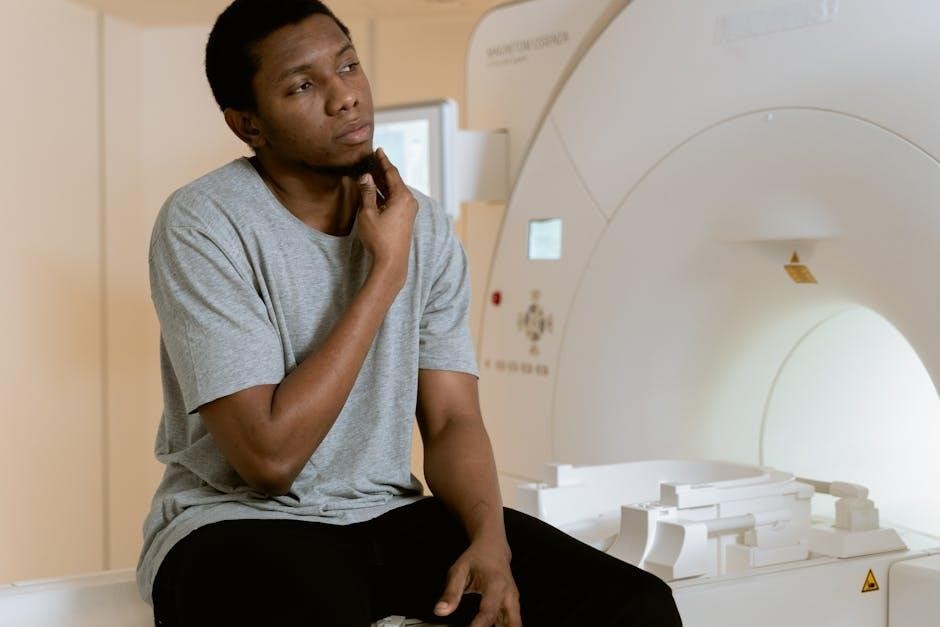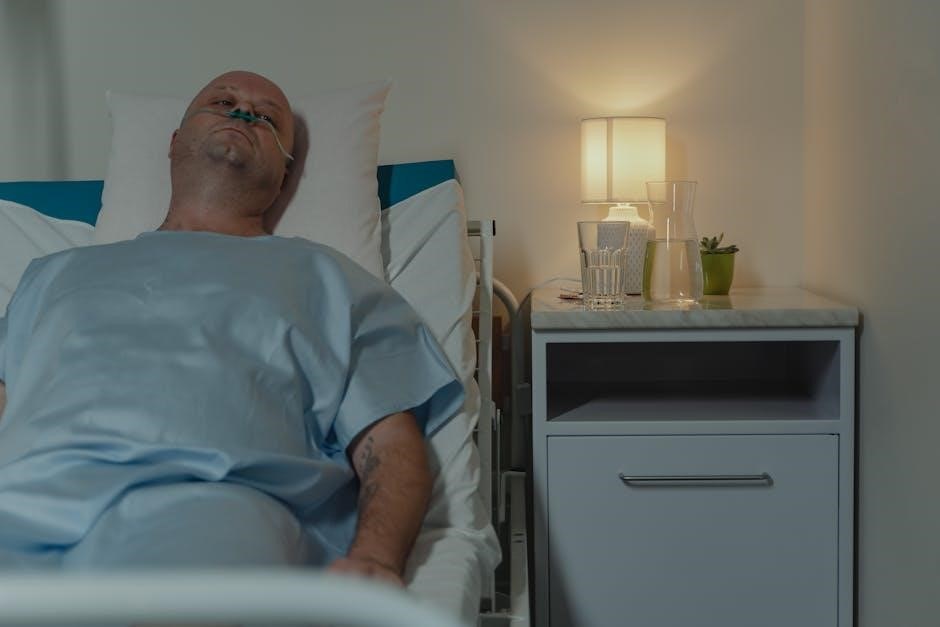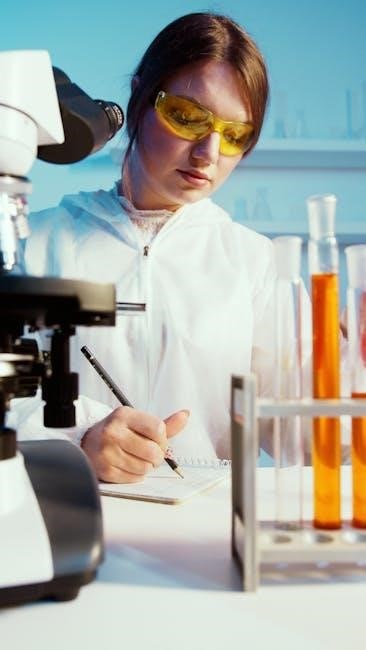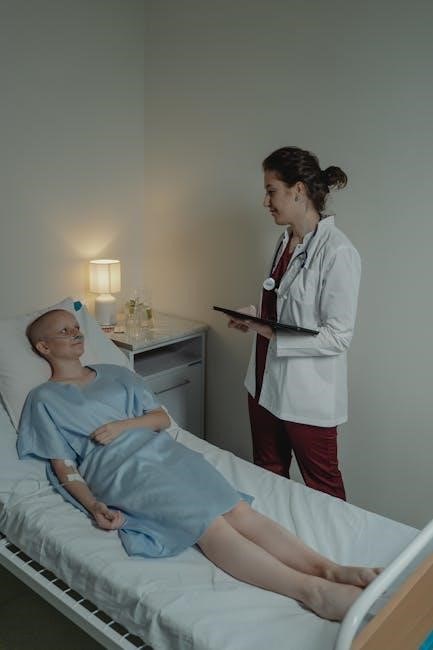
Sever’s Disease is a common cause of heel pain in adolescents, typically during growth spurts. It affects the growth plate, causing significant discomfort. Stretching exercises are essential for relief.
What is Sever’s Disease?
Sever’s Disease, also known as calcaneal apophysitis, is a common condition that causes heel pain in children and adolescents. It occurs when the growth plate in the heel bone (calcaneus) becomes inflamed due to repetitive stress or strain. This condition is most prevalent during growth spurts, typically affecting individuals between the ages of 7 and 15. Symptoms include pain at the back or bottom of the heel, which may worsen during physical activity. It is often associated with tight calf muscles or an Achilles tendon that pulls on the growth plate. While it can be uncomfortable, Sever’s Disease is not arthritis and usually resolves with proper management, including rest and stretching exercises.
Common Causes and Risk Factors
Sever’s Disease is primarily caused by repetitive stress on the heel’s growth plate, often due to tight calf muscles or an Achilles tendon pulling on the heel bone. Risk factors include growth spurts, particularly in children aged 7-15, participation in sports involving running or jumping, and improper footwear. Overuse during physical activities can exacerbate the condition, while genetic predisposition may also play a role. Additionally, structural issues like flat feet or high arches can increase susceptibility. Identifying these causes and risk factors is crucial for effective prevention and management, often through targeted stretching exercises and activity modification.
Importance of Stretching in Managing Sever’s Disease
Stretching is a cornerstone in managing Sever’s Disease, as it helps alleviate pain and inflammation by reducing tension in the calf muscles and Achilles tendon. Regular stretching improves flexibility, enhancing joint mobility and reducing stress on the growth plate. It also promotes blood flow, aiding in the healing process. Strengthening exercises can complement stretching to build muscle support around the affected area. Consistency is key, as irregular stretching may not provide sufficient relief. Incorporating a daily stretching routine can significantly reduce discomfort and prevent future episodes, making it an essential component of both treatment and prevention strategies for Sever’s Disease.

Understanding the Role of Stretching
Stretching improves flexibility, reduces muscle tightness, and alleviates discomfort in Sever’s Disease. Regular stretching enhances blood flow, supports the healing process, and prevents further irritation of the growth plate.
How Stretching Helps Alleviate Symptoms

Stretching plays a crucial role in reducing the discomfort associated with Sever’s Disease by targeting tight calf and hamstring muscles. Regular stretching improves blood flow to the affected area, which can help reduce inflammation and promote healing. It also enhances flexibility, making daily activities less painful. Stretching decreases muscle tension around the Achilles tendon, which is often a primary source of pain. By consistently performing stretches, individuals can alleviate heel pain and create a more stable environment for the growth plate to heal. This approach not only provides immediate relief but also supports long-term recovery and prevents future episodes of discomfort.
Best Times to Perform Stretches
Stretching is most effective when done consistently, ideally before and after physical activity to prevent tightness and reduce the risk of discomfort. Morning stretches can help address muscle stiffness, while evening routines promote relaxation and recovery. For individuals with Sever’s Disease, stretching after activity helps alleviate soreness and reduces inflammation. It is recommended to hold each stretch for 20-30 seconds and repeat 2-3 times for optimal results. Incorporating stretching into a daily routine, especially during growth spurts, can significantly improve symptoms. Consistency is key, as irregular stretching may not provide adequate relief. Always consult a healthcare provider to tailor a stretching schedule to individual needs.
Preventing Future Episodes with Regular Stretching
Regular stretching plays a crucial role in preventing future episodes of Sever’s Disease by maintaining muscle flexibility and reducing tightness. Consistent stretching routines target the calf and hamstring muscles, which are often tight in individuals with this condition. Strengthening exercises, particularly for the lower leg, also contribute to long-term prevention. Incorporating activities like yoga or Pilates can enhance overall flexibility and strength. It is important to establish a daily stretching habit, even after symptoms subside, to avoid recurrence. Parents and athletes should prioritize proper warm-up and cool-down practices during sports activities. A well-structured stretching plan, combined with appropriate footwear and activity modification, can effectively prevent future episodes and promote lasting relief.

Effective Stretches for Sever’s Disease
Targeted stretches like gastrocnemius, soleus, and heel dips alleviate symptoms and strengthen muscles. A Sever’s Disease stretches PDF guide offers easy-to-follow routines for daily practice and relief.
Gastrocnemius Stretch
The gastrocnemius stretch is a key exercise for managing Sever’s Disease, targeting the calf muscles. Stand facing a wall, one hand on it for balance. Step one foot back about a foot, keeping the heel on the ground and bending the front knee slightly. Lean forward until a stretch is felt in the calf. Hold for 30 seconds, then switch legs. This stretch helps reduce tightness in the Achilles tendon, which contributes to heel pain. Regular practice, as outlined in a Sever’s Disease stretches PDF, can improve flexibility and alleviate discomfort. Perform 2-3 times daily for optimal results.

Soleus Stretch

The soleus stretch targets the lower calf muscles and is particularly effective for Sever’s Disease. Sit on the floor with your legs extended straight. Loop a towel around the ball of one foot, holding both ends. Gently pull the towel toward you, keeping your knee straight, until a stretch is felt in the lower calf. Hold for 30 seconds, then release and repeat 2-3 times on each leg. This stretch is especially beneficial for reducing tightness in the Achilles tendon and relieving heel pain. Including this exercise in your daily routine, as detailed in a Sever’s Disease stretches PDF, can significantly improve flexibility and comfort.
Heel Dips
Heel dips are an effective exercise for reducing heel pain associated with Sever’s Disease. To perform this stretch, stand on the edge of a stair or sturdy step with your heels hanging off the edge. Slowly lower your heels below the step level, stretching the Achilles tendon and calf muscles. Hold the stretch for 20-30 seconds before returning to the starting position. Repeat this 3-5 times. Heel dips are particularly beneficial for loosening tight calf muscles and improving ankle flexibility. Including this exercise in a Sever’s Disease stretches PDF can help individuals manage symptoms effectively. Regular practice promotes healing and prevents future discomfort.
Towel Stretch
The towel stretch is a simple yet effective exercise for managing Sever’s Disease symptoms. Sit on the floor with your legs straight out in front of you. Loop a towel around the ball of your foot and gently pull the towel toward you, keeping your knee straight. Hold the stretch for 20-30 seconds and repeat 3-5 times on each leg. This exercise targets the calf muscles and Achilles tendon, providing relief from tightness and pain. It’s an excellent option for individuals who may find standing stretches challenging. Incorporating the towel stretch into a Sever’s Disease stretches PDF ensures easy access to this beneficial exercise, promoting consistent practice and symptom relief.
Towel Scrunches
Towel scrunches are a valuable exercise for managing Sever’s Disease, focusing on the muscles in the feet and calves. Place a towel flat on the floor and sit in a chair or on the floor with your feet on it. Using your toes, scrunch the towel toward you in small bunches, holding for a few seconds each time. Repeat this motion 10-15 times, ensuring a gentle stretch in the arch and calf; This exercise strengthens the toes and improves flexibility, reducing tension in the Achilles tendon. Including towel scrunches in a Sever’s Disease stretches PDF provides a convenient way to practice this exercise regularly, aiding in symptom relief and recovery.
Seated Calf Stretch
The seated calf stretch is an effective exercise for alleviating Sever’s Disease symptoms by targeting the calf muscles and Achilles tendon. Sit on the floor with your legs extended straight out. Loop a towel or resistance band around the ball of one foot, holding the ends in your hands. Gently pull the towel toward you, keeping your knee straight, until you feel a stretch in your calf. Hold for 20-30 seconds, then release and repeat 2-3 times on each leg. This stretch helps reduce tightness in the calf muscles and Achilles tendon, which is often a contributing factor to Sever’s Disease. Including this exercise in a Sever’s Disease stretches PDF ensures easy access to this beneficial routine for consistent practice and recovery.

Additional Exercises for Support
Yoga and Pilates enhance flexibility and core strength, while strengthening exercises target the lower leg, providing comprehensive support for managing Sever’s Disease symptoms effectively.
Yoga for Flexibility and Strength
Yoga is an excellent way to improve flexibility and strength, particularly in the calves and hamstrings, which are often tight in individuals with Sever’s Disease. Poses like downward-facing dog, child’s pose, and warrior II can gently stretch the Achilles tendon and calf muscles. These exercises promote balance, alignment, and overall lower limb stability. Yoga also enhances core strength, which is crucial for proper movement mechanics. By incorporating yoga into a daily routine, individuals can reduce muscle tension and improve joint mobility. It’s important to focus on slow, controlled movements and hold stretches for 20-30 seconds to maximize benefits. Regular yoga practice can complement stretching routines and aid in long-term recovery from Sever’s Disease.
Pilates for Core and Calf Stability
Pilates is an effective method to enhance core strength and calf stability, which are crucial for managing Sever’s Disease. By focusing on controlled movements and proper alignment, Pilates helps improve posture and reduce strain on the lower limbs. Exercises such as calf raises, leg circles, and footwork on the reformer can strengthen the muscles around the ankles and calves without putting excessive stress on the growth plates. Additionally, Pilates promotes balance and overall muscle coordination, which can help prevent future episodes of Sever’s Disease. Incorporating Pilates into a rehabilitation routine can complement stretching and provide long-term benefits for mobility and stability. It’s a low-impact option that is gentle on joints while still delivering significant improvements in strength and flexibility.
Strengthening Exercises for the Lower Leg
Strengthening exercises for the lower leg are vital for managing Sever’s Disease, as they help build muscle support around the affected area. Calf raises, heel dips, and toe curls are effective options. These exercises target the Achilles tendon and calf muscles, improving their endurance and reducing strain on the growth plate. Using resistance bands or light weights can enhance the intensity. Performing these exercises 2-3 times a week promotes muscle balance and stability, which are essential for recovery. Strengthening also enhances overall lower limb function, making it easier to return to physical activities. Consistency is key to achieving long-term benefits and preventing recurrence of Sever’s Disease symptoms.

Preventing Sever’s Disease
Preventing Sever’s Disease involves proper footwear, orthotics, and activity modification. Regular stretching and avoiding overuse can reduce risk. Maintaining flexibility and strength is also crucial for prevention.
Proper Footwear and Orthotics
Wearing proper footwear is essential for managing and preventing Sever’s Disease. Shoes should provide adequate cushioning, support, and flexibility to reduce stress on the heel. Orthotics, such as custom inserts, can help redistribute pressure and alleviate discomfort. Avoiding flat or unsupportive shoes is crucial, especially during growth spurts. Orthotics can address issues like flat feet or high arches, which may contribute to the condition. Consulting a podiatrist or healthcare professional can help determine the best footwear and orthotic solutions. Proper footwear not only supports recovery but also helps prevent future episodes by reducing strain on the growth plate and surrounding tissues.
Activity Modification for Recovery
Modifying activities is crucial for recovery from Sever’s Disease. Reducing participation in high-impact sports and avoiding repetitive stress on the heel can significantly alleviate symptoms. Rest is essential to prevent further irritation of the growth plate. Activities should be adjusted to low-impact options, such as swimming or cycling, which minimize stress on the heel. Gradually returning to normal activities after symptoms improve is recommended. Overexertion can lead to prolonged recovery, so monitoring activity levels is vital. Incorporating rest periods and avoiding hard surfaces or uneven terrain can also support healing. This approach, combined with stretching and orthotics, helps ensure a full and sustainable recovery from Sever’s Disease.
Daily Stretching Routine
A consistent daily stretching routine is vital for managing Sever’s Disease. Begin with gentle calf and hamstring stretches, holding each for 20-30 seconds and repeating 2-3 times. Incorporate heel dips, towel stretches, and seated calf stretches to target tight muscles. Perform these exercises morning and night, especially before and after physical activity, to improve flexibility and reduce stiffness. Regular stretching helps alleviate heel pain and prevents recurrence. Consistency is key to maintaining muscle length and promoting long-term recovery. A well-structured routine can significantly enhance comfort and support overall lower leg health, making it easier to manage daily activities without discomfort. Stick to the routine faithfully for optimal results.

Creating a Sever’s Disease Stretches PDF
A well-organized PDF guide featuring detailed stretches, visuals, and instructions helps individuals manage Sever’s Disease effectively. Include images, step-by-step directions, and a daily routine for easy reference.

Organizing the Stretching Guide
Organizing a Sever’s Disease stretching guide involves categorizing exercises by difficulty and purpose. Start with introductory stretches like Gastrocnemius and Soleus stretches, followed by intermediate exercises such as Heel Dips and Towel Stretches. Include advanced options like Seated Calf Stretches and Towel Scrunches. Use visuals to demonstrate proper form and provide step-by-step instructions. Dedicate sections for morning and evening routines, ensuring clarity and ease of use. Add a section for frequency and duration, recommending 2-3 sets per exercise. Conclude with a daily schedule template for consistency. This structured approach ensures users can follow the guide efficiently, making it a valuable resource for managing Sever’s Disease.
Including Visual Aids and Instructions
Including high-quality images and detailed instructions in a Sever’s Disease stretching guide enhances understanding and proper execution. Use diagrams to illustrate each stretch’s starting and ending positions, highlighting key muscle groups. Provide step-by-step instructions, emphasizing alignment and breathing techniques. Include duration and repetition guidelines for each exercise. Add arrows on images to indicate movement direction, ensuring clarity. Incorporate before-and-after visuals to show progression and proper form. Use clear, concise language in instructions, avoiding technical jargon. Make instructions accessible for both children and parents, fostering a collaborative approach to recovery. This comprehensive visual and instructional support ensures users can perform stretches safely and effectively, maximizing the guide’s benefits for managing Sever’s Disease.
Sharing the Guide for Widespread Use
Sharing the Sever’s Disease stretches guide ensures widespread access to essential exercises for managing symptoms. Distribute the PDF via email, social media, or healthcare platforms to reach parents, coaches, and physical therapists. Print copies can be handed out at clinics or schools, while digital versions can be shared on websites or forums. Encourage users to forward the guide to others who may benefit, fostering a community-focused approach to pain management. Highlight the guide’s effectiveness in reducing heel pain and promoting recovery. By sharing, you help children and adolescents worldwide access proven stretches and exercises to alleviate Sever’s Disease discomfort and prevent future episodes.
Consistent stretching and proper care are vital for managing Sever’s Disease. Regular exercises promote long-term relief and prevent future episodes, ensuring healthy growth and active lifestyles for children.
Long-Term Benefits of Stretching
Regular stretching provides lasting relief from Sever’s Disease symptoms and prevents future episodes. Over time, it improves flexibility, strengthens calf and hamstring muscles, and promotes proper muscle balance. Consistent stretching routines help manage growth spurts effectively, reducing heel pain and discomfort. Additionally, it enhances overall mobility and supports active lifestyles. By incorporating stretching into daily routines, individuals can achieve sustained relief and maintain healthy muscle function. Long-term adherence to stretching exercises ensures better mobility and reduces the likelihood of recurrence, fostering a proactive approach to managing Sever’s Disease.
Encouraging Consistency and Patience
Consistency is key to managing Sever’s Disease effectively. Regular stretching and exercise routines may not yield immediate results, but over time, they significantly reduce pain and inflammation. Parents and caregivers should emphasize the importance of daily stretching to help children stay committed, even when progress seems slow. Patience is crucial, as recovery and growth require time. Encouraging a positive mindset helps individuals adhere to their routines and view stretching as a long-term investment in their health.
By fostering consistency and patience, individuals can better navigate the challenges of Sever’s Disease, leading to lasting relief and stronger, more resilient muscles. This approach ensures a smoother recovery process and prevents future episodes.